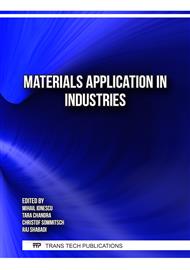[1]
M. Heiden, E. Walker, L. Stanciu, Magnesium, Iron and Zinc Alloys, the Trifecta of Bioresorbable Orthopaedic and Vascular Implantation - A Review. J. Biotechnol. Biomater. 5 (2) (2015) 1000176
DOI: 10.4172/2155-952x.1000178
Google Scholar
[2]
Y.F. Zheng, X.N. Gu, F. Witte, Biodegradable metals, Mater. Sci. Eng. R Rep. 77 (2014) 1-34.
Google Scholar
[3]
H.-S. Han, S. Loffredo, I. Jun et al., Current status and outlook on the clinical translation of biodegradable metals, Mater. Today. 23 (2019) 57–71.
DOI: 10.1016/j.mattod.2018.05.018
Google Scholar
[4]
H. Hermawan, D. Dubé, D. Mantovani, Developments in metallic biodegradable stents, Acta Biomater. 6 (2010) 1693–1697.
DOI: 10.1016/j.actbio.2009.10.006
Google Scholar
[5]
M. Moravej, D. Mantovani, Biodegradable Metals for Cardiovascular Stent Application: Interests and New Opportunities, Int. J. Mol. Sci. 12 (2011) 4250–4270.
DOI: 10.3390/ijms12074250
Google Scholar
[6]
B. Liu, Y.F. Zheng, Effects of alloying elements (Mn, Co., Al, W, Sn, B, C and S) on biodegradability and in vitro biocompatibility of pure iron, Acta Biomater. 7 (2011) 1407–1420.
DOI: 10.1016/j.actbio.2010.11.001
Google Scholar
[7]
H. Hermawan, D. Dube, D. Mantovani, Degradable metallic biomaterials: design and development of Fe-Mn alloys for stents, J. Biomed. Mater. Res. A 93 (2010) 1–11.
DOI: 10.1002/jbm.a.32224
Google Scholar
[8]
M. Schinhammer, A.C. Hänzi, J.F. Löffler et al., Design strategy for biodegradable Fe-based alloys for medical applications, Acta Biomater. 6 (2010) 1705–1713.
DOI: 10.1016/j.actbio.2009.07.039
Google Scholar
[9]
Hermawan H, Alamdari H, Mantovani D et al., Iron-manganese: new class of degradable metallic biomaterials prepared by powder metallurgy, Powder Metall. 51 (2008) 38–45.
DOI: 10.1179/174329008x284868
Google Scholar
[10]
M. Moravej, F. Prima, M. Fiset et al., Electroformed iron as new biomaterial for degradable stents: development process and structure-properties relationship, Acta Biomater. 6 (2010) 1726–1735.
DOI: 10.1016/j.actbio.2010.01.010
Google Scholar
[11]
F.L. Nie, Y.F. Zheng, S.C. Wei et al., In vitro corrosion, cytotoxicity and hemocompatibility of bulk nanocrystalline pure iron, Biomed. Mater. 5 (2010) 65015.
DOI: 10.1088/1748-6041/5/6/065015
Google Scholar
[12]
O.V. Rybalchenko, N.Yu. Anisimova, M.V. Kiselevsky et al., Effect of equal-channel angular pressing on structure and properties of Fe-Mn-С alloys for biomedical applications, Mater. Today Commun. 30 (2022) 103048.
DOI: 10.1016/j.mtcomm.2021.103048
Google Scholar
[13]
S.W. Youn, M.J. Kim, Effect of manganese content on the magnetic susceptibility of ferrous-manganese alloys: correlation between microstructure on X-Ray diffraction and size of the low-intensity area on MRI, Investig. Magn. Reson. Imaging 19 (2015) 76–87.
DOI: 10.13104/imri.2015.19.2.76
Google Scholar
[14]
J. Fiocchi, C.A. Biffi, S. Gambaro et al., Effect of laser welding on the mechanical and degradation behaviour of Fe-20Mn-0.6C bioabsorbable alloy, J. Mater. Res. Technol. 9 (6) (2020) 13474–13482.
DOI: 10.1016/j.jmrt.2020.09.104
Google Scholar
[15]
W.L. Xu, X. Lu, L.L. Tan et al.. Study on properties of a novel biodegradable Fe-30Mn-1C alloy, Acta Metall. Sin. (Engl. Lett.) 47 (2011) 1342–1347.
Google Scholar
[16]
C.N.J. Wagner. Analysis of the broadening and change in position of peaks in an X-ray powder pattern. In: Cohen JB, Hilliard JE (Eds.), Local atomic arrangement studied by X-ray diffraction, Gordon and Breach, New York, 1966, p.219.
Google Scholar
[17]
B.E. Warren. X-ray diffraction. Dover Publications, Inc., New York, 1990.
Google Scholar
[18]
L.J. Teutonico, The dissociation of dislocations in the face-centered cubic structure, Acta Metall. 11(1963) 1283–1289.
DOI: 10.1016/0001-6160(63)90023-3
Google Scholar
[19]
J.W. Christian, S. Mahajan, Deformation Twinning, Prog. Mater. Sci. 39 (1995) 1–157.
Google Scholar
[20]
L. Vitos, J.O. Nilsson, B. Johansson, Alloying effects on the stacking fault energy in austenitic stainless steels from first-principles theory, Acta Mater. 54 (2006) 3821–3826.
DOI: 10.1016/j.actamat.2006.04.013
Google Scholar
[21]
R.E. Schramm, R.P. Reed, Stacking fault energies of seven commercial austenitic stainless steels, Metall. Mater. Trans. A 6 (1975) 1345–1351.
DOI: 10.1007/bf02641927
Google Scholar
[22]
J.X. Yan, Z.J. Zhang, H. Yu et al., Effects of pressure on the generalized stacking fault energy and twinning propensity of face-centered cubic metals, J. Alloys Compd. 866 (2021) 158869.
DOI: 10.1016/j.jallcom.2021.158869
Google Scholar
[23]
T. Yonezawa, K. Suzuki, S. Ooki, The effect of chemical composition and heat treatment conditions on stacking fault energy for Fe-Cr-Ni austenitic stainless steel, Metall. Mater. Trans. A: Phys. Metall. Mater. Sci. 44 (2013) 5884–5896.
DOI: 10.1007/s11661-013-1943-0
Google Scholar
[24]
T.H. Lee, E. Shin, C.S. Oh et al., Correlation between stacking fault energy and deformation microstructure in high-interstitial-alloyed austenitic steels, Acta Mater., 58 (2010) 3173–3186.
DOI: 10.1016/j.actamat.2010.01.056
Google Scholar
[25]
S. Allain, J.P.P. Chateau, O. Bouaziz, A physical model of the twinning-induced plasticity effect in a high manganese austenitic steel, Mater. Sci. Eng. A, 387–389 (2004) 143-147.
DOI: 10.1016/j.msea.2004.01.060
Google Scholar
[26]
Y. Tian, O.I. Gorbatov, A. Borgenstam et al., Deformation microstructure and deformation-induced martensite in austenitic Fe-Cr-Ni alloys depending on stacking fault energy, Metall. Mater. Trans. A Phys. Metall. Mater. Sci. 48 (2017) 1–7.
DOI: 10.1007/s11661-016-3839-2
Google Scholar
[27]
E. Gerashi, R. Alizadeh, T.G. Langdon, Effect of crystallographic texture and twinning on the corrosion behavior of Mg alloys: A review. J. Magnes. Alloy. 10 (2) (2022) 313–325.
DOI: 10.1016/j.jma.2021.09.009
Google Scholar



